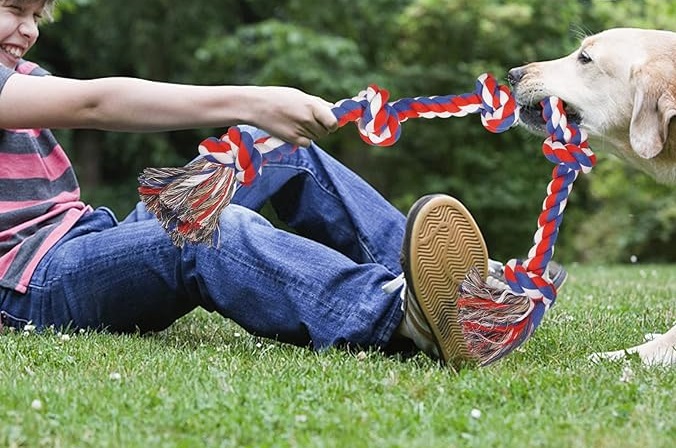Unlocking the Secrets of Your Dog’s Love for Tug of War Dog Toy
Introduction: The Thrill of the Tug
Hey there, fellow dog parents! Do your eyes meet that glint of ecstasy in your pup’s eyes whenever you so much as hover your hand over their favorite tug of war dog toy? If your fur baby is anything like mine, they probably do more than just wag their tails; we’re talking Olympic-level gymnastics here!
You and I both know that tug of war isn’t just another mundane game we play to pass the time with our furry friends. But if you’re still on the fence, let me tell you, you’re massively underestimating what that tug of war dog toy can do. Ready to find out?
A Personal Confession: Changing My Stance
Let me take a step back and confess something. Initially, I held the belief that playing tug of war could potentially encourage aggressive behavior in dogs. However, after research and heartwarming playtime with my pup, I am here to tell you—I was wrong!
The Psychology Behind the Game: The Science of the Tug
Wondering what goes on in that furry little head during a game of tug of war? Is it just a game, or is there more to this doggie favorite? Well, buckle up because we’re about to explore the canine psyche!
Prey Drive: Tapping into Ancient Instincts
The urge to tug doesn’t come from a place of wanting to dominate you or rip the toy out of your hands. It’s about instinct, deeply rooted in their biological makeup. When your dog engages in a game of tug of war, they’re essentially tapping into their ‘prey drive.’ That pull-and-tug motion mimics the sensation of what it would feel like to pull on prey. It’s almost like you’re giving them a little piece of the wild, right in your living room. And this satisfies a very primal urge.
Bonding Time: A Dance Between Two Souls
Believe it or not, when you play tug of war, you’re engaging in a complex social interaction with your dog. This is as much a bonding activity as going for walks or cuddling on the couch. Both of you have to be in sync—knowing when to pull, when to hold, and when to let go. It’s a two-way street, a dance if you will, where both partners need to be in harmony for the performance to be a success.
Mental Stimulation: Strategic Thinking
You might think it’s all about who has the most muscle, but you’d be missing the point. Tug of war isn’t just a physical game; it’s a mental workout for your pooch. Dogs have to strategize how to win the tug of war dog toy from you, considering things like when to pull harder, when to give slack, or when to change their grip. This requires a level of focus and strategic thinking that many people overlook. Tug of war provides a unique form of mental exercise, requiring focus and strategy.
The Underestimated Benefits of Playing with a Tug of War Toy with Your Dog
Physical Exercise: A Canine Gym in Your Living Room
Let’s start with the obvious. Tug of war is a game of pulling and tugging, which sounds simple but packs a punch in terms of physical benefits. Think about it as the equivalent of a doggie gym session. Have you ever tried to win a tug of war match against a committed pooch? It’s exhausting!
Your dog uses almost every muscle in their body in an attempt to out-pull you. Their legs for leverage, their back for strength, and their neck and jaw muscles for holding onto the toy. The game is particularly beneficial for building core strength and muscle tone, making it excellent for your dog’s overall physical health.
Mental Exercise: The Chessboard of Dog Games
Alright, I know what you’re thinking, “Chess? Really?” But hear me out! A tug of war isn’t just about brute strength; it’s a battle of wits too. While it might look like your pup is just randomly pulling, there’s actually a lot of mental exercise involved.
For example, your dog has to assess when to tug, when to hold, and when to let go to catch you off balance. It’s a constant game of strategy, almost like they’re solving a puzzle. With every pull and every grip change, they’re making quick decisions and using problem-solving skills. So, it’s not just their bodies that are getting a workout; their brains are flexing some muscles too!
Obedience Training: The Fun Way to Learn Commands
Here’s where things get even more interesting. How about incorporating some obedience training while you’re at it? That’s right; your tug of war dog toy can also be a tool for teaching commands and behaviors. If you’ve ever tried teaching your pup the “Drop it!” or “Leave it!” commands, you know it can be a bit of a drag.
However, weave these commands into a game of tug of war, and voila! Training suddenly becomes way more compelling for your dog. You can use the game to reward your pup for obeying commands instantly, and trust me, they’re more likely to remember it when there’s play involved. This way, you’re not only reinforcing positive behaviors but doing it in a way that’s fun for both of you.
Choosing the Right Tug of War Dog Toy
All toys are not created equal. Make sure you choose toys specifically designed for tug of war.
Features to consider
Ensure the tug of war dog toy is durable, safe for their teeth, and easy for both you and your dog to grip.
Material
Go for strong, durable materials like nylon or rubber, designed to withstand a good chew.
Durability
Choose a toy that can withstand your dog’s enthusiasm. The last thing you want is it breaking mid-tug!
Size and Shape
The toy should fit your dog’s mouth comfortably. Anything too big or small could be a choking hazard.
Tips and Tricks for a Safe Game
To ensure a fun, injury-free game, some guidelines are vital.
Establishing rules
Training your dog to release the toy on command ensures control during playtime.
Knowing when to stop
If the game gets too intense, it’s essential to take breaks and ensure it remains a positive experience.
Dental Concerns
If your pup has dental issues, this high-impact game could make things worse. Be cautious not to pull excessively when playing tug-of-war, as it can lead to dental injuries. If your canine companion is still a pup, it’s best to steer clear of this game for the time being. Their oral structures are in a state of development, and excessive tugging can lead to issues with their jaw alignment or bite and future teeth development.
Conclusion: The Multifaceted Benefits of Tug of War
So, the next time you pick up that tug of war dog toy, remember you’re not just keeping your pup entertained. You’re also giving them a physical workout, a mental challenge, and even a lesson in obedience, all rolled into one. Additionally, it’s an enriching experience that fulfills their instinctual needs, strengthens your bond, and keeps their minds sharp. What other game offers such a comprehensive package?
Tug of war is more than just a way to kill some time; it’s a multifaceted tool that can contribute positively to many aspects of your dog’s life. It has converted me from a skeptic into a true believer, and I have a feeling it might do the same for you. Ready to grab that tug of war dog toy and unleash some fun?
FAQs
Q1: Is tug of war safe for all dog breeds?
A: Yes, but always consider your dog’s size and health conditions and choose the right tug of war dog toy size for your breed.
Q2: How often should I play tug of war with my dog?
A: It depends on your dog’s energy levels, but daily sessions can be beneficial. Moderation is key. Keep sessions short and sweet to avoid any stress or strain.
Q3: Can tug of war replace daily walks?
A: No, it should be an addition to your dog’s regular exercise routine. Both activities offer different kinds of stimulation and exercise.
Q4: Is it okay to let my dog win at tug of war?
A: Absolutely! It’s good for their confidence, but it’s also beneficial for them to learn impulse control when they don’t win.
Q5: What if my dog becomes possessive of the toy?
A: Training commands like “drop it” or “leave it” can help maintain control. If played correctly and with set rules and boundaries, tug of war should not promote aggression.




